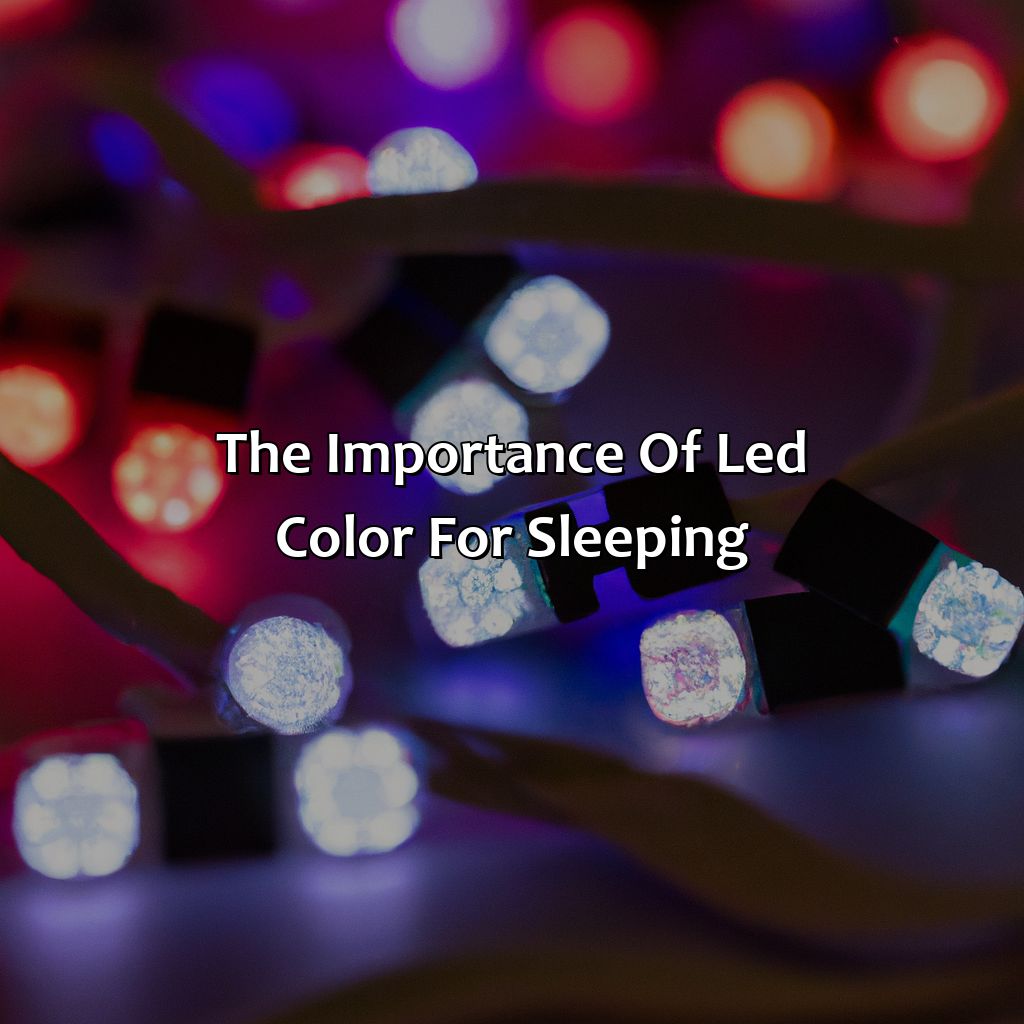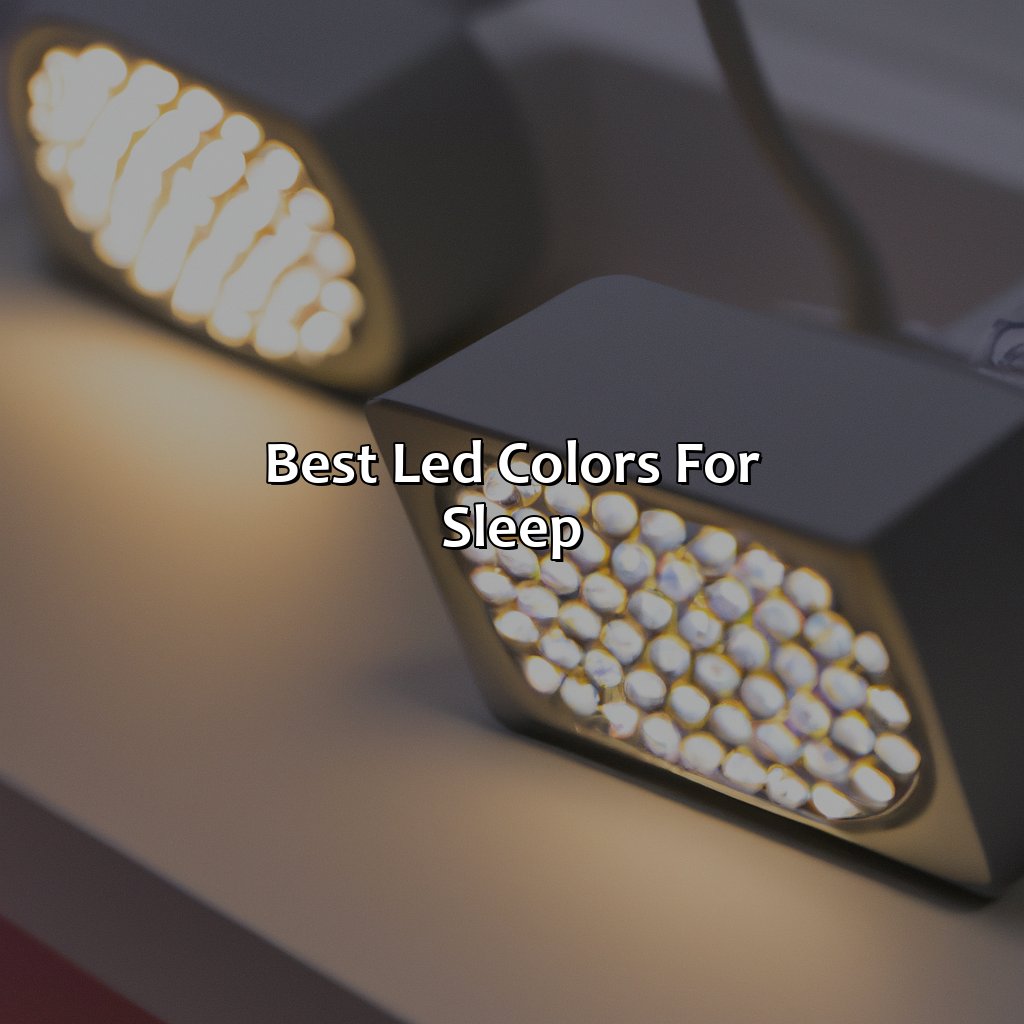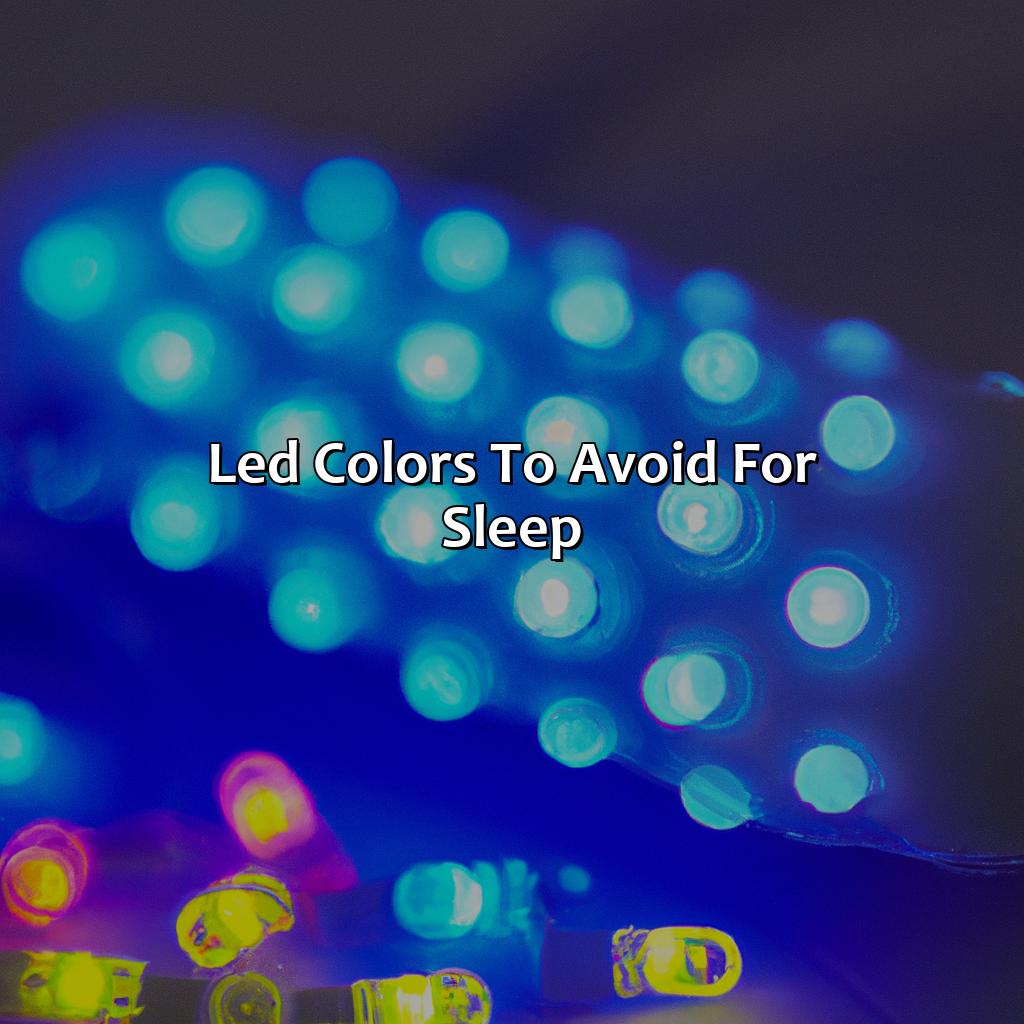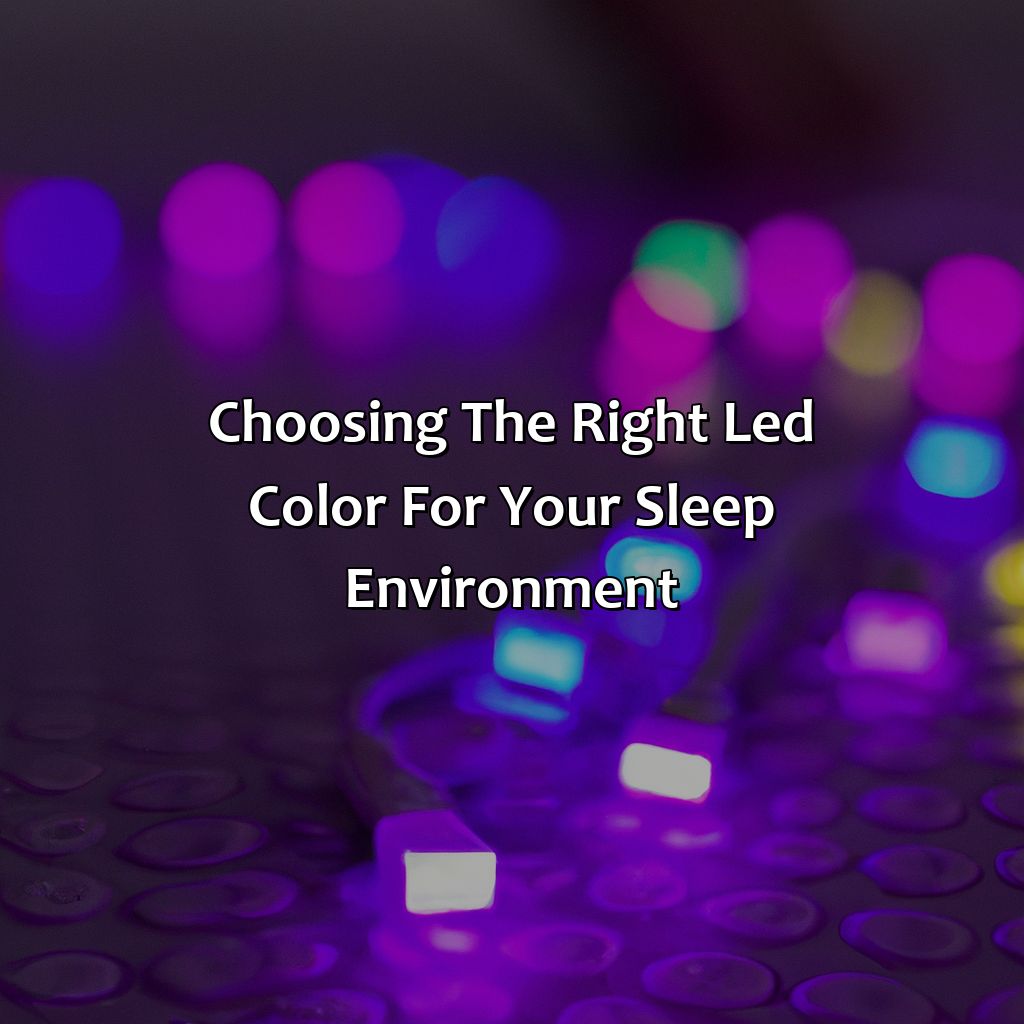Key Takeaway:
- The best LED color to sleep with is warm white or amber, as these colors have the least amount of blue light that can interfere with melatonin production, regulate the circadian rhythm, and promote deeper sleep.
- Red, orange, and yellow LEDs can also be good options for sleeping, as they have lower levels of blue light and create a calming, relaxing effect that can enhance mood and reduce stress.
- It is important to avoid blue and green LEDs for sleeping, as these colors can suppress melatonin production, disrupt sleep patterns, and cause sleep disturbances, insomnia, and fatigue.
- When choosing the right LED color for your sleep environment, consider factors such as dimming and brightness, color temperature, and color changing LEDs that can simulate natural light and support healthy sleep habits.
- To improve your sleep quality, consider adopting a bedtime routine, using light-blocking shades or candlelight, using essential oils or relaxation techniques, and investing in sleep technology or smart home automation that can enhance your sleep environment and promote overall wellness.
The Importance of LED Color for Sleeping

Photo Credits: colorscombo.com by Patrick Perez
Want better sleep? Adjust your bedroom lighting LED color! To find the best color for sleeping, we’ll look at two things. First, LED Color and Sleep Hormones. Second, LED Color and Melatonin Production. Both are essential for a good night’s rest. So, choose your LED color wisely!
LED Color and Sleep Hormones
The LED color in our surroundings plays a critical role in regulating the secretion of sleep hormones, which is crucial for ensuring a good night’s sleep. The appropriate LED color has been shown to facilitate melatonin production, the hormone that helps regulate our natural sleep-wake cycles. Blue light from LEDs disrupts this process, resulting in lower melatonin levels and making it more challenging to fall asleep.
Choosing the right LED color temperature can aid in improving our sleep quality by avoiding disrupting the body’s production of melatonin. Avoiding blue and green lights on your phone or other electronic devices before bed may also prevent these issues.
It’s not just the color of the LED that matters; the intensity and brightness can also affect sleep patterns. Lower-intensity lights with warm tones may have positive effects on increasing melatonin production while brighter tones or harsher light sources can decrease it.
Pro Tip: Stick to warm-white, amber, red, orange or yellow-colored LEDs to promote restful sleep and avoid using devices emitting blue lights an hour before bedtime.
Finding the right LED color for your sleep environment can be a real melatonin masterpiece.
LED Color and Melatonin Production
Melatonin is a hormone responsible for regulating sleep wake cycles, and its production is influenced by various factors, including LED color. The wavelength of light emitted by LEDs affects melatonin production as it interferes with the circadian rhythm. Melatonin levels are at its lowest during daylight hours, but when exposed to cooler light hues emitted by LEDs like blue and green, it can suppress its production, making it difficult to fall asleep. Therefore, it is crucial to choose the right LED color that promotes rather than hinders melatonin production.
Studies have shown that warmer hues of LED colors like red, amber, and orange stimulate melatonin secretion as they emit less blue light. This is because warmer hues have longer wavelengths and less energy compared to blue light wavelengths which interfere with sleep hormones. Yellow LEDs also have a higher efficacy in producing melatonin compared to other colors, although not much research has been conducted on this. Choosing warm-hued lights instead of cooler ones can thus improve melatonin levels in the body.
Additionally, it is important not only to pick the right hue but also adjust the brightness level of your LED bulbs for suitable sleep levels. If you opt for brighter or cooler bulbs at night times, you might end up resetting your body clock leading to delayed sleep patterns affecting your overall health in the long run.
I remember when I recently found myself struggling with getting proper rest each night; my friend suggested me changing the bulbs from blue-white lights emitting from them during nights. I installed warm-hued LED lights in my room, accomplishing a pleasant ambiance while providing benefits for somnolence too – I was able to gain better sleep after just one week of installation! It’s impressive how small changes could positively impact our routine and functioning as a whole.
Sleep tight with warm whites, ambers, reds, oranges, or yellows – the best LED colors for a restful sleep.
Best LED Colors for Sleep

Photo Credits: colorscombo.com by Stephen Scott
Optimize your sleep! Pick the right LED color. LEDs with a calming effect help you relax and let go of the day’s stress. We present the five best LED colors for sleep. These will give you a restful sleep and an energizing morning. The colors are:
- Warm White,
- Amber,
- Red,
- Orange,
- and Yellow LEDs.
Warm White LEDs
Warm white LED lights emit a soft, yellow-white light that is similar to traditional incandescent bulbs. They have a color temperature of around 2700K to 3000K, which creates a relaxing and cozy atmosphere perfect for promoting sleep. The warm white LEDs mimic the natural light of the sunset, which helps stimulate the production of melatonin in the body, making it easier to fall asleep.
Unlike cool-toned LEDs or fluorescent bulbs, warm white LEDs do not interfere with your body’s circadian rhythm as much. This means they won’t inhibit melatonin secretion as significantly before bed and throughout the night, ensuring better quality sleep. According to research studies, warm white LEDs are found to be an excellent choice for bedside lamps as they create a calm ambiance that relaxes the mind and helps individuals drift off into deep sleep.
To enhance its effectiveness further, try using dimmable warm white LED bulbs; this will give more control over brightness levels compared with standard on/off switches. Additionally, use lampshades that diffuse light well or tilt them downwards to prevent any bright spots on walls and ceilings within your sleep space; this way you’ll ensure that you don’t disrupt melatonin production while sleeping soundly all night long.
Sleeping with amber LEDs is like cuddling with a warm blanket for your eyes.
Amber LEDs
In addition to promoting sleep, amber LEDs also provide a soft, warm glow that creates a calming and soothing atmosphere in the bedroom. This makes them an excellent option for use as bedside lamps or night lights. Unlike blue or green LEDs, which can be overstimulating and disruptive to sleep, amber LEDs are gentle on the eyes and won’t interfere with circadian rhythms.
Pro Tip: When selecting amber LED bulbs or fixtures for your sleep environment, look for those with adjustable dimming options to create a customized level of brightness.
Sleep like a baby with the warm glow of red LEDs – without the crying and diaper changes.
Red LEDs
The color red has unique effects on our sleep patterns due to its association with darkness and comfort. Red LED lights have been found to promote relaxation and improve sleep quality by increasing melatonin production in the brain. Red light also helps regulate the circadian rhythm, reducing the risk of sleep disturbances and insomnia. In addition, studies have shown that exposure to red light can reduce anxiety and stress levels for a better night’s sleep.
Research has demonstrated that exposure to red LED lighting in the evening can significantly impact the quality of restful sleep experienced during the night. This benefit is particularly significant for individuals who frequently use electronic devices such as phones or laptops before bed. The blue light emitted by these devices reduces melatonin production and disrupts natural circadian rhythms, which can cause difficulty falling asleep.
Through using red LEDs as part of your bedroom lighting scheme, you will promote deep, rejuvenating sleep cycles without interrupting your body’s natural processes or causing irritation from high-color temperatures.
One successful implementation of red LEDs is at a hospital facility designed specifically for patients with mental health needs experiencing sleeping problems. The hospital installed adjustable RGBW LED lights over every bed in patient rooms so they could select their preferred lighting according to mood or activity – including warm whites, cool whites for concentration, and blue-enriched white lights – but found that most patients chose integrated RGBW LEDs set at low-light levels. Patients were observed having lower anxiety levels during their stay at this hospital due to this color choice strategy employed through lighting design innovation.
Sleep better with an orange glow – why orange LEDs might just be the key to your sweet dreams.
Orange LEDs
Along with warm white and amber LEDs, orange LEDs can promote optimal sleep quality. The soft glow of orange light provides a soothing atmosphere that relaxes the body to prepare for sleep. Orange LEDs operate at low frequencies, which help reduce melatonin suppression produced by other types of lights.
Orange LEDs are also useful in promoting lucid dreaming, allowing individuals to experience vivid dreams. In addition, studies have shown orange light boosts serotonin levels, which increases feelings of happiness and relaxation.
To enhance your sleep environment using orange LEDs, consider installing them in bedside lamps or wall sconces. Notably, these should be dimmed gradually as bedtime approaches. Additionally, ensure the dimmer control is within reach if you need to adjust it during the night.
Overall, the use of orange LEDs as a source of nighttime lighting not only reduces exposure to harmful blue light but also enhances sleep quality by promoting relaxation and melatonin production while reducing stress levels.
Sleeping with yellow LEDs is like cuddling with a warm golden retriever – comforting and relaxing.
Yellow LEDs
In addition to its calming effect on the body, yellow light can also improve cognitive function and reduce anxiety levels. This is due to the fact that it activates the parasympathetic nervous system, which is responsible for promoting feelings of relaxation and calmness in the body.
Pro Tip: When using yellow LEDs in your sleep environment, opt for dimmable bulbs that allow you to adjust brightness levels based on your needs. This way, you can create a customized atmosphere that meets your individual sleep preferences.
Don’t let blue or green LEDs ruin your sleep, stick to warmer tones instead.
LED Colors to Avoid for Sleep

Photo Credits: colorscombo.com by Andrew Hill
Sleep is important! To keep it that way, pick the right LED color. Avoid Blue and Green LEDs – they can mess with your sleep quality. Let’s take a look at the issues associated with these colors. Sub-sections below explain.
Blue LEDs
The following table shows the Effects on Sleep:
| Effects on Sleep | Details |
| Disruption of Melatonin Production | Blue LEDs at night suppress the production of melatonin, an essential hormone for establishing healthy sleep patterns. |
| Wakefulness Promotion | The cool-toned light emitted by blue LEDs sends a signal to the brain that it is daytime, inducing wakefulness and reducing drowsiness. |
| Circadian Rhythm Disruption | Prolonged exposure to blue LED light at night can disrupt the body’s natural circadian rhythm, leading to poor quality sleep and fatigue during daytime hours. |
It is important to note that some blue light exposure during the day is beneficial for maintaining a healthy circadian rhythm. However, when it comes to bedtime, it is best to steer clear of blue LED lights in order to promote restful and restorative sleep.
According to Harvard Health Publishing, “blue wavelengths—which are beneficial during daylight hours because they boost attention, reaction times, and mood—seem to be the most disruptive at night.”
Green LEDs may be great for the environment, but they’ll definitely keep you up all night.
Green LEDs
LED colors have a direct impact on sleep quality, and green LEDs may not be the best option for bedtime. Green LEDs emit a significant amount of blue light which can suppress melatonin production, causing difficulty in falling asleep. While green light may be helpful in enhancing alertness and mood during the day, it can negatively affect sleep.
Additionally, recent studies have suggested that exposure to green LED light before bedtime can lead to circadian rhythm disruption. This disruption can cause issues with daily routine and affect overall health significantly. Therefore, it’s vital to avoid green LEDs during sleeping hours.
To optimize sleep quality, it is recommended to use warm white, amber, red, orange or yellow LED bulbs in the bedroom instead of green LEDs. These colors promote melatonin production and suppress circadian rhythm disruption caused by bright lights.
Finding the perfect LED color for your sleep environment is like a science experiment: experiment with dimming, color temperature, and color-changing LEDs to get the best result.
Choosing the Right LED Color for Your Sleep Environment

Photo Credits: colorscombo.com by Eric Scott
Choose the best LED color for your sleep environment? To get a good night’s rest, consider dimming and brightness, color temperature and color-changing LEDs. This section focuses on providing a solution. We’ll explore sub-sections such as Dimming and Brightness, Color Temperature and Color-Changing LEDs to help you sleep better.
Dimming and Brightness
The influence of dimming and brightness on sleep patterns is crucial, as excessive light can hinder melatonin production and lead to disrupted circadian rhythms. In contrast, low levels of brightness support the natural production of sleep hormones, allowing for a more restful night’s sleep. Adjusting this aspect can improve the quality of sleep and overall health.
One way to maximize the effectiveness of dimming and brightness is through dimmer switches or use of smart lights that allow users to adjust brightness levels gradually throughout the evening. This solution addresses bright light’s negative impact on melatonin production at night and assists the body’s natural rhythms when waking in the morning. Combining this with warm white or amber LEDs helps create a calming environment conducive to relaxation.
In addition, some scientists suggest using timed light therapy to regulate circadian rhythms-for example, soft amber lighting 30 minutes before bedtime-to simulate natural sundowns. Furthermore, it’s recommended that light sources in the sleeping area are dimmed 60-90 minutes before going to bed as it takes time for our bodies to respond.
By following these recommendations about adjusting the brightness level progressively with warm-toned LEDs and starting early enough, individuals can achieve deeper sleep patterns without interruption or disturbances from overbearing blue or green lighting interfering with their restfulness.
Let’s talk about color temperature, because it’s not just for fancy mood lighting anymore.
Color Temperature
LED Color Temperature is a crucial aspect to consider when selecting LED lights for sleep environments. It refers to the warmth or coolness of light measured in Kelvin. Lower Kelvin values indicate warm, yellowish colors, while higher Kelvin values reflect cooler, bluish hues. The color temperature plays an essential role in regulating melatonin production and sleep-wake cycles by mimicking natural sunlight patterns.
Choosing the appropriate color temperature can create a relaxing ambiance for promoting good quality rest, aiding wakefulness during daylight hours and improve mental well-being. Generally, warm white LEDs ranging from 2000-3000K are ideal for inducing relaxation and drowsiness before bed, while those with higher temperatures of 5000K or greater may induce alertness.
A niche detail regarding color temperature is that our internal body clocks respond best to lower kelvin rated lights during bedtime hours due to their similarity with candlelight around dusk. Reducing the levels towards the yellow end of the spectrum helps suppress cortisol levels – one of our waking hormones.
Pro Tip – Experimentation is key; tweaking the lighting temperature to find what works best for your individual sleep preferences might be something worth considering. Changing LED colors might be fun, but use caution when it comes to your sleep environment.
Color Changing LEDs
Although we have discussed different LED colors for sleep in the previous sections, there’s another type of LEDs that is gaining popularity when it comes to sleep lighting – color changing LEDs. These LEDs allow you to adjust the color temperature and brightness according to your preference and mood, making them a versatile option.
Here are 6 key points about color changing LEDs:
- Color changing LEDs support circadian rhythm by mimicking natural light cycles.
- They provide flexibility in adjusting light accordingly as per day, mood or room decor.
- Sleep experts recommend programmed settings for gradual transitioning events toward bedtime.
- Some models can be controlled with voice commands using assistants like Amazon Alexa or Google Home.
- The transition speed and range of adjustments vary depending on the model and brand chosen.
- Color changing LED kits are available with built-in timers or memory function suitable for smart home integration.
It’s essential to note that installing a simple LED bulb cannot account for all variables to optimize your sleep. Special features of color-changing lights reflect circadian lighting needs, which means LED color temperature, brightness level, hue, and saturation levels should be adjusted accordingly.
Finally, if you are genuinely interested in improving your sleep quality with soft ambient lighting support that follows the solar cycles accurately or enhances comfort at night time, it may be worth exploring these smarter options. Don’t miss out on exciting new possibilities offered by color-changing LEDs!
Sleep tight with the right light: choose warm white, amber, red, or yellow LEDs for a better rest, and avoid blue and green ones like the plague.
Summary
LED color plays a crucial role in regulating sleep hormones, specifically melatonin production. Warm white LEDs, amber LEDs, red LEDs, orange LEDs and yellow LEDs are the best LED colors for sleep due to their low blue light content. On the other hand, blue LEDs and green LEDs should be avoided as they suppress melatonin production. When choosing the right LED color for your sleep environment, consider dimming and brightness levels, color temperature, and even color-changing capabilities. Pro Tip: Reducing exposure to electronics with blue light before bedtime can also improve sleep quality.
Recommendations
LED colors impact our sleep quality, and choosing the correct color is crucial for a better sleep experience. Below are five recommendations to consider when selecting an LED color for your sleeping environment:
- Warm white LEDs – provide a relaxing cozy atmosphere.
- Amber LEDs – create an orange-yellow warm glow which mimics sunset and promotes relaxation.
- Red LEDs – creates very low-light conditions, blocking the transmission of several sleep-disrupting hormones
- Orange LEDs – Produce calmness and help regulate circadian rhythms until we’re ready to sleep.
- Yellow LEDs – provide an anxious-free state of mind as well as a serene tranquil nighttime vision.
It’s worth noting that avoiding certain LED colors like green or blue will restrict melatonin production. Also, opt for dimming control, variable brightness and specific light intensity based on your sleeping environment. Additionally, selecting color-changing LEDs can promote enhanced daytime cognition while soothing transition to night-time relaxation.
Finally, It’s important not to forget that what works well for someone else might not work out for you as it is true for a client who chose amber but suggested Green LED lighting after testing nighttime glare on their eyes.
Some Facts About the Best LED Color to Sleep With:
- ✅ The best LED color to sleep with is red, as it promotes the production of melatonin, a hormone that regulates sleep. (Source: Healthline)
- ✅ Blue LED light can negatively affect sleep quality and disrupt circadian rhythms, making it harder to fall asleep and stay asleep. (Source: Harvard Health Publishing)
- ✅ Green LED light has been found to promote relaxation and reduce stress, making it a good color for those who have trouble falling asleep due to anxiety. (Source: Sleep Foundation)
- ✅ Amber LED light has also been found to promote the production of melatonin, making it a good option for those who prefer a warmer, more relaxing color. (Source: SleepScore Labs)
- ✅ White LED light can also negatively affect sleep quality, but using dimmer, warmer white lights can help mitigate this effect. (Source: The Guardian)
FAQs about What Is The Best Led Color To Sleep With
What is the best LED color to sleep with?
The best LED color to sleep with is red. This color has been proven to have the least impact on your natural circadian rhythm and promotes relaxation.
Can I use a blue LED light for sleeping?
No, blue LED lights can actually disrupt your sleep patterns and lead to a less restful night. It is best to avoid blue light before bed.
What about yellow or orange LED lights?
Yellow or orange LED lights can be a good choice for sleeping, as they promote relaxation and a calming atmosphere. However, red is still the best option for maintaining your natural circadian rhythm.
Are there any other colors to avoid for sleeping?
Avoid bright and intense colors like green, blue, and white. These colors can keep you alert and energized, making it more difficult to fall asleep and stay asleep.
Can I use a dimmer switch with my LED lights for sleeping?
Yes, using a dimmer switch with your LED lights can help create a softer and more relaxing atmosphere in your bedroom. This can signal to your brain that it is time to wind down and prepare for sleep.
Can LED lights with different color temperatures affect my sleep?
Yes, LED lights with higher color temperatures (such as cool white) can stimulate your brain and make it more difficult to fall asleep. It is best to use LED lights with lower color temperatures (such as warm white) for sleeping.






